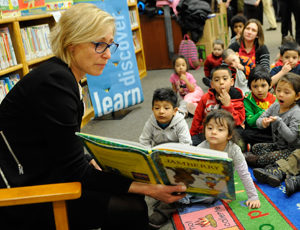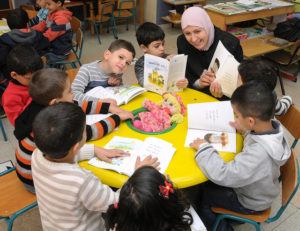 RESEARCH BRIEFS
RESEARCH BRIEFS
[div class=”research-brief”]The following research briefs are based on academic papers published by CCEC researchers, faculty associates, and affiliates in a wide range of top academic journals. They highlight timely research summaries of selected articles of interest to scholars, practitioners, and policy makers.[end-div]
Recommended Dose For Print Referencing
 STAR Read-Aloud Practices are based on the tenets of print referencing. Print referencing is an evidence-based technique that has been shown to increase children’s print knowledge. Print referencing has been implemented with varying intensity. More recently, researchers have sought to determine the recommended dose for print referencing. The results of various studies support a recommended dose of six teaching episodes during two book-reading sessions per week for 30 weeks, for a total of 360 teaching episodes.
STAR Read-Aloud Practices are based on the tenets of print referencing. Print referencing is an evidence-based technique that has been shown to increase children’s print knowledge. Print referencing has been implemented with varying intensity. More recently, researchers have sought to determine the recommended dose for print referencing. The results of various studies support a recommended dose of six teaching episodes during two book-reading sessions per week for 30 weeks, for a total of 360 teaching episodes.
The History of STAR Read-Aloud Practices
 STAR Read-Aloud Practices are based on print referencing and have been developed over two decades of research.
STAR Read-Aloud Practices are based on print referencing and have been developed over two decades of research.
Print Referencing with Special Populations

STAR Read-Aloud Practices are based on print referencing. Print referencing is an evidence-based read-aloud practice that is designed to boost children’s print knowledge. Although print referencing can help develop emergent-literacy skills for all preschoolers, these techniques have been shown to be particularly beneficial for special populations including children living in poverty, children with developmental disabilities, and children from culturally and linguistically diverse backgrounds.
[div id=”accordion”]
Highlighted Citations
[div]
Dynia, J. M., Justice, L. M., Pentimonti, J. M., Piasta, S. B., & Kaderavek, J. N. (2013). Text features and preschool teachers’ use of print referencing. Journal of Research in Reading, 36, 261–279. doi: 10.1111/j.1467-9817.2011.01502.x
Epstein, J. L., & Sanders, M. G. (2006). Prospects for change: Preparing educators for school, family, and community partnerships. Peabody Journal of Education, 81(2), 81-120.
Ezell, H. K., & Justice, L. M. (1998). A pilot investigation of parents’ questions about print and pictures to preschoolers with language delay. Child Language Teaching and Therapy 14(3), 273-278.
Ezell, H. K., & Justice, L. M. (2000). Increasing the print focus of adult-child shared book reading through observational learning. American Journal of Speech-Language Pathology, 9(1), 36-47.
Ezell, H. K., Justice, L. M., & Parsons, D. (2000). Enhancing the emergent literacy skills of pre-schoolers with communication disorders: A pilot investigation. Child Language Teaching & Therapy, 16(2), 121-140. doi: 10.1177/026565900001600202
Justice, L. M., & Ezell, H. K. (2000). Enhancing children’s print and word awareness through home-based parent intervention. American Journal of Speech-Language Pathology, 9(3), 257-269.
Justice, L. M., & Ezell, H. K. (2002). Use of storybook reading to increase print awareness in at-risk children. American Journal of Speech-Language Pathology, 11(1), 17-29. doi: 10.1044/1058-0360(2002/003)
Justice, L. M., & Ezell, H. K. (2004). Print referencing: An emergent literacy enhancement strategy and its clinical applications. Language, Speech, and Hearing Services in Schools, 35(2), 185-193. doi: 10.1044/0161-1461(2004/018)
Justice, L. M., & Kaderavek, J. N. (2004). Embedded-explicit emergent literacy intervention i: Background and description of approach. Language, Speech, and Hearing Services in Schools, 35(3), 201. doi: 10.1044/0161-1461(2004/020)
Justice, L. M., Kaderavek, J. N., Fan, X., Sofka, A. E., & Hunt, A. (2009). Accelerating preschoolers’ early literacy development through classroom-based teacher-child storybook reading and explicit print referencing. Language, Speech, and Hearing Services in Schools, 40(1), 67-85. doi: 10.1044/0161-1461(2008/07-0098)
Justice, L. M., & Lankford, C. (2002). Preschool children’s visual attention to print during storybook reading: Pilot findings. Communication Disorders Quarterly, 24(1), 9-19. doi: 10.1177/152574010202400103
Justice, L. M., Logan, J. A.R., Kaderavek, J. N., & Dynia, J. M. (2015). Print-focused read-alouds in early childhood special education programs. Exceptional Children, 81(3), 292-311. doi: 10.1177/0014402914563693
Justice, L. M., McGinty, A. S., Piasta, S. B., Kaderavek, J. N., & Fan, X. (2010). Print-focused read-alouds in preschool classrooms: Intervention effectiveness and moderators of child outcomes. Language, Speech & Hearing Services in the Schools, 41, 504-520. doi: 10.1044/0161-1461(2010/09-0056)
Justice, L. M., & Piasta, S. (2011). Developing children’s print knowledge through adult-child storybook reading interactions: Print referencing as an instructional practice. In S. B. Neuman & D. K. Dickinson (Eds.), Handbook of early literacy research (Vol. 3, pp. 200-213). New York: Guildford Press.
Justice, L. M., Pullen, P. C., & Pence, K. L. (2008). Influence of verbal and nonverbal references to print on preschoolers’ visual attention to print during storybook reading. Developmental Psychology, 44(3), 855-866. doi: 10.1037/0012-1649.44.3.855
Justice, L. M., Skibbe, L. E., Canning, A., & Lankford, C. (2005). Pre-schoolers, print and storybooks: An observational study using eye movement analysis. Journal of Research in Reading, 28(3), 229-243.
Justice, L. M., Skibbe, L. E., McGinty, A. S., Piasta, S. B., & Petrill, S. A. (2011). Feasibility, efficacy, and social validity of home-based storybook reading intervention for children with language impairment. Journal of Speech, Language and Hearing Research, 54(2), 523-538. doi: 10.1044/1092-4388(2010/09-0151)
Justice, L. M., & Sofka, A. (2005). Calling attention to print: An implementation manual. Charlottesville, VA: Preschool Language and Literacy Lab, University of Virginia.
Justice, L. M., & Sofka, A. E. (2010). Engaging children with print: Building early literacy skills through quality read-alouds. New York: Guilford Press.
McGinty, A. S., Breit-Smith, A., Fan, X., Justice, L. M., & Kaderavek, J. N. (2011). Does dosage matter? Preschoolers’ emergent literacy growth in high- and low-dosage classroom-based intervention. Early Childhood Research Quarterly, 26, 255-267. doi: 10.1016/j.ecresq.2011.02.002
Piasta, S. B., Dynia, J. M., Justice, L. M., Pentimonti, J. M., Kaderavek, J. N., & Schatschneider, C. (2010). Impact of professional development on preschool teachers’ print references during shared read alouds: A latent growth curve analysis. Journal of Research on Educational Effectiveness, 3(4), 343-380. doi: 10.1080/19345747.2010.482177
Piasta, S. B., Justice, L. M., McGinty, A. S., & Kaderavek, J. N. (2012). Increasing young children’s contact with print during shared reading: Longitudinal effects on literacy achievement. Child Development, 83(3), 810-820. doi: 10.1111/j.1467-8624.2012.01754.x
Pratt, A. S., Justice, L. M., Perez, A., & Duran, L. K. (2015). Impacts of parent-implemented early-literacy intervention for Spanish-speaking children with language impairment. International Journal of Language & Communication Disorders, 50(5), 569-579. doi:http://dx.doi.org/10.1111/1460-6984.12140
[end-div]
[end-div]
